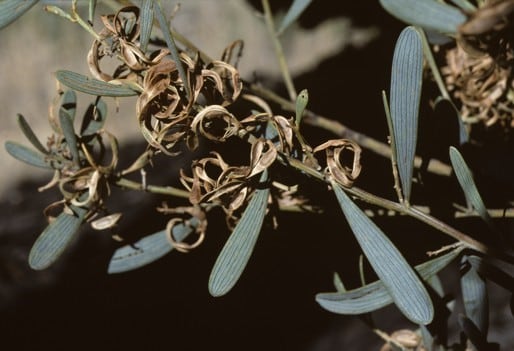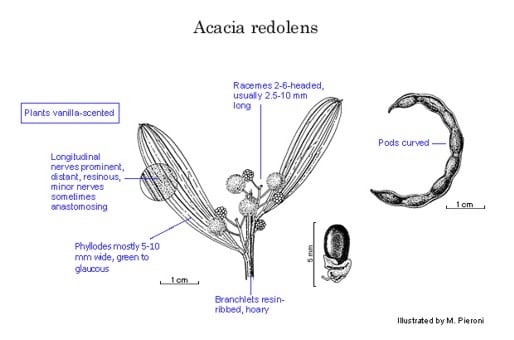Acacia redolens Maslin
WATTLE
Acacias of Australia
Family
Fabaceae
Distribution
Occurs from Ongerup E to near Ravensthorpe but also found near Newdegate and Pingrup., south-western W.A.
Description
Spreading, prostrate to low-domed shrub normally 0.5–1.5 (–2) m high, rarely an erect shrub to 3 (–4) m high. Branchlets resin-ribbed, hoary around phyllode bases and often between ribs. Phyllodes normally oblanceolate to narrowly oblong-oblanceolate, straight to shallowly incurved, 2.5–7 cm long, (2–) 5–10 (–20) mm wide, rounded or obtuse, distinctively vanilla-scented, grey-green or glaucous, glabrous except appressed-puberulous at base, with many prominent distant resinous nerves and reticulate or not in between, 3- or 4-nerved on very narrow phyllodes; gland at distal end of pulvinus. Inflorescences 2–6-headed racemes; raceme axes usually 2.5–10 mm long, normally tomentose or appressed-puberulous and resinous; peduncles 2–5.5 mm long, with indumentum as on raceme axes; heads globular, 3–5 mm diam., densely 20–30-flowered, golden. Flowers 5-merous; sepals ±free. Pods narrowly linear, arcuate, to 6 cm long, 2–3.5 mm wide, thinly coriaceous, glabrous. Seeds longitudinal, narrowly elliptic-oblong, 3.5–4 mm long, glossy, dark brown; aril cream-white.
Habitat
Found in slightly saline or alkaline loam, clay or clay loam, often with Salmon Gums (Eucalyptus salmonophloia) or Stocking Gum (E. kondinensis) and frequently around margins of salt lakes.
Specimens
W.A.: 9.6 km E of Ravensthorpe towards Esperance, B.R.Maslin 2573 (CANB, K, L, MEL, PERTH); 1.6 km W of Lake Bryde, K.Newbey 3675 (PERTH); c. 10 km W of Fitzgerald R. near S coast, P.G.Wilson 10151 (PERTH).
Notes
Very closely related to A. bartlei; also to A. trineura from eastern Australia which has ±straight pods and dark green phyllodes with generally fewer longitudinal nerves of which only 1–3 extend to the apical point (many nerves extending to the apex in A. redolens). Superficially similar to A. cyclops which is most readily distinguished by its larger flower-heads, pods and seeds, and the seeds with a distinctive encircling red or orange funicle/aril. Also similar to A. warramaba.
The ‘A. ixiophylla’ referred to by B.R.Maslin in the protologue of A. redolens was subsequently described as A. verricula.
The species has been utilised in the U.S.A. for median strip planting and for reclamation of degraded sites; it is also grown very well in windy coastal situations under extreme conditions, fide B.R.Maslin, Nuytsia 1: 327 (1974).
A rare variant with unusually narrow (2–3 mm wide), linear phyllodes occurs around Pingrup (e.g. W.E.Blackall 3034, PERTH). However, the plants with narrow phyllodes from near Esperance that were noted by R.S.Cowan & B.R.Maslin, Fl. Australia 11B: 44 (2001), are now described as A. bartlei. Racemes on cultivated specimens can reach 20 mm long. Acacia redolens typically occurs as prostrate, domed shrubs 0.5–1.5 (–2) m tall and spreading to 5 m or more across; they rarely develop as erect shrubs to 3 (–4) m tall, the tallest of which are found in the lower reaches of the Fitzgerald R. c. 70 km due SE of Ravensthorpe.
FOA Reference
Data derived from Flora of Australia Volumes 11A (2001), 11B (2001) and 12 (1998), products of ABRS, ©Commonwealth of Australia
Author
R.S.Cowan, B.R.Maslin
This identification key and fact sheets are available as a mobile application:
URL: https://apps.lucidcentral.org/wattle/
© Copyright 2018. All rights reserved.










